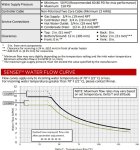cantbreak80
Maybe I need new clubs
The threaded plug on top of the tank is not tightened...it's just installed with 1-2 threads...just to keep debris from contaminating the glycol.
"The system is operating with the fill port loosely installed…so, it’s basically and open system". Could you explain this in a little more detail? How is this an open system?
The threaded plug on top of the tank is not tightened...it's just installed with 1-2 threads...just to keep debris from contaminating the glycol.
Makes sense, thanks!The threaded plug on top of the tank is not tightened...it's just installed with 1-2 threads...just to keep debris from contaminating the glycol.
Pay Once...Cry Once.
I'm now thinking of not going with a tank and circulator pump on the DHW. It would save so much space. In order to prevent pump starvation I could put in a second float valve plumbed with cold water in the gravity tank set a little lower. It is hard to tell how often it would be needed but would probably only be in the winter when the incoming water is cooler. I believe the plumber is installing a Rinnai CU199iN. Is there a simpler setup without using a tank and circulator pump?

Ours has a pvc pipe coming out and a 180 degree turn down to prevent dirt entry.
After looking at the spec sheet for the CU199iN, I would think you would need a backup water supply to your hot gravity tank like you mentioned...Also did you see a minimum water supply pressure of 50psi? Recommended 60-80psi.....At a 60° delta, you are looking at 6gpm output rating...I forget how many bays you have? If you are running a softener, you'd need to know what your pressure is after the softener, since it creates head pressure. One thing missing from their flow chart is water pressure. Water pressure has a direct effect on output gpm....To get the advertised 11gpm, I'm thinking you would have to supply it with 150psi pressure. In their warning note, they are substituting "Altitude" for pressure! All three affect final output flow in gpm.
I know I have quite a bit of head pressure in my 1" Fleck softener, about 15-20 psi drop across the softener which is the spec. We had a main break in town that wasn't filling the towers. So pressure dropped to about 30psi coming in to my wash...I had to add an additional water supply (hydrominder, its all I had) to my cold gravity tank and plumb it from in front of my softener. Without it, when all 4 bays were running HP, I would run out of water in my gravity tanks (10gal each) in just a few minutes. Plumbing in water from ahead of my softener was enough to keep the gravity tanks happy! I know I could have bypassed my softener, but this works too. At a normal 45 psi incoming pressure, I am good to go running 100% through the softener. So all things to consider when sizing things up to work the way you want them too.
My 1" softener is marginal for my 4bay because of the head pressure resistance and flow rates. With a 1" service, I should get 40 gpm, but since the softener is only rated at about 20gpm, that makes my system marginal....I have a 1.5" Fleck 9500 and all 1.5" plumbing that I need to install! It would give me double the capacity and margin of error....A pretty big job I'm not wanting to take on in the middle of winter!
View attachment 10288
2" water meter and 2" softener piping. 52 PSI after the meter and 42 PSI after the backflow preventer. 18 PSI drop when the touchless auto was running but I thought that was due to the resin going bad. So what would happen if this tankless water heater was installed? Not run at all? Not have any flow until 50+ PSI? What if someone's house was on a well? Mine has a pressure switch set between 40 and 60 which is typical but some have a 30-50 PSI switch.
Hey 2 Biz. I remember you cleaned the loop and also implemented a larger strainer to replace the tiny screen on the input water, can you elaborate on those items?
Not quite the way I remember it!!! See link below and post #27 is where I mention cleaning the system and the small filter screen in the Takagi...I did not replace the filter screen with anything bigger...I just cleaned it and reinstalled it. What I did was put a 5 micron filter inline using the 2 service ports and a sump pump in a 15 gallon barrel to filter the zones..I ran the main zone pump, the sump pump, and 5 micron filter for 24 hours without running the heater. No glycol was circulating through the heater while I was cleaning the zone loops. That was 12 years ago...I haven't had to do anything to the small filter screen since...Still get the same 6GPM through the heater as I did 12 years ago.
(26) Tankless Water Heater For Floor Heat | Page 2 | Car Wash Forum


Not quite the way I remember it!!! See link below and post #27 is where I mention cleaning the system and the small filter screen in the Takagi...I did not replace the filter screen with anything bigger...I just cleaned it and reinstalled it. What I did was put a 5 micron filter inline using the 2 service ports and a sump pump in a 15 gallon barrel to filter the zones..I ran the main zone pump, the sump pump, and 5 micron filter for 24 hours without running the heater. No glycol was circulating through the heater while I was cleaning the zone loops. That was 12 years ago...I haven't had to do anything to the small filter screen since...Still get the same 6GPM through the heater as I did 12 years ago.
(26) Tankless Water Heater For Floor Heat | Page 2 | Car Wash Forum

Thanks for reminding me. The cleaning of the loops was ongoing until you were satisfied it was good. What solution did you find for the cleaning? I will reread the oldpost but want to thank you for documentation that you have done.Not quite the way I remember it!!! See link below and post #27 is where I mention cleaning the system and the small filter screen in the Takagi...I did not replace the filter screen with anything bigger...I just cleaned it and reinstalled it. What I did was put a 5 micron filter inline using the 2 service ports and a sump pump in a 15 gallon barrel to filter the zones..I ran the main zone pump, the sump pump, and 5 micron filter for 24 hours without running the heater. No glycol was circulating through the heater while I was cleaning the zone loops. That was 12 years ago...I haven't had to do anything to the small filter screen since...Still get the same 6GPM through the heater as I did 12 years ago.
(26) Tankless Water Heater For Floor Heat | Page 2 | Car Wash Forum



Good question...I found a very good video showing how to plumb multiple heaters into the main floor heat loop. It takes him 2 minutes to explain what would take me a lot longer here on the forum! The video is how I would do it except for one change. Instead of running the pumps in parallel like in his first diagram, I would plumb the heaters like I have mine in series to get double the pressure. You would tee between the pumps and heaters so both heaters see the same higher inlet pressure. MOST of these demand heaters get their throughput based on the inlet pressure. With (2) 013 Tacos in series, I get 40psi and 6gpm throughput...(1) Taco 013 and I got 20 psi and 3gpm output both at 105° temp output...The resulting differences was exactly like what was documented in some of the online publications I found. Pumps in series multiply or add the pressure of each pump to get final output pressure. Pumps in parallel has more volumn but output pressure is same as one pump.


